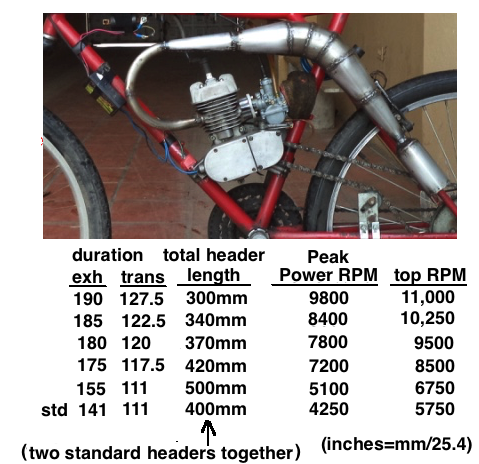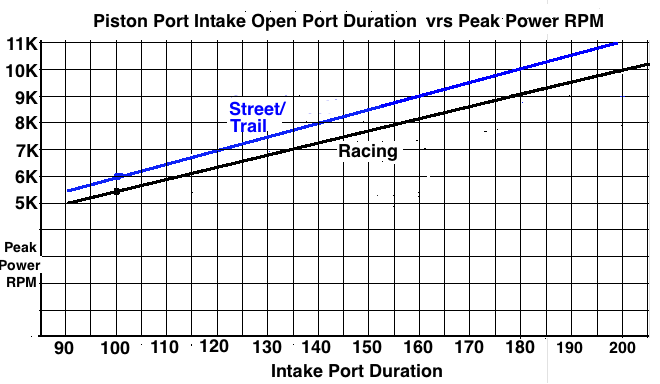Porting the Chinese HT engineI use an online port duration calculator after measuring port heights, to know the port open durations in degrees. Anyone can use a digital caliper to figure out the port durations by measuring the "deck" (distance below the top of cyliner that the piston edge is at TDC) and the distance from port tops to cylinder top. Click here to go to a good on-line port duration calculator. (Use 38 for stroke, 85 for conrod, .8 for "deck").Click here to see my list of the most basic porting tools.  There's two ways to describe the port timing of each port. One, the most common, is to describe the total amount of crank degrees the port is open during one crank rotation. The second way is to tell at what crank degrees, in relation to zero degrees (piston top dead center), the port begins to open. From top dead center to bottom dead center, one half rotation, is 180 degrees. So if the exhaust port opens at 110 ATDC (after top dead center) then to get the total open port duration you'd subtract 110 from 180 and multiply by two. So 180-110=70. 70x2=140. 110°ATDC is 140° duration. If the intake port of a piston port engine (like the Grubee) opens around 60°BTDC (before top dead center) then you can figure the duration just by multiplying by two. That would equal 120° duration. For changing any port, more duration is for higher rpm power and less duration befits lower rpm power. Standard Engine: 141° exhaust duration (28mm from top of cylinder), 111° transfer duration (32mm), 112° intake duration (55.5mm), 44.8mm piston length at intake side, .8mm deck height, 38mm stroke. This engine is ported for a mild low rpm power, maxing at around 5500 RPM. I would raise its exhaust port 1.6mm and widen it 4mm (2mm each side) for a stronger power at top RPM, and to raise that ceiling a bit. I'd leave the transfers alone except for making sure both have the same height. And I would widen the intake port a few millimeters but leave its duration as is. If you need more speed you can change the rear sprocket to one with less teeth or raise the exhaust port even more. A 10% decrease in number of teeth will result in a 10% increase in speed. But this change reduces your ability to accelerate and climb streets.  Porting can be done at home with a rotary tool that uses the common 1/8" diameter shank bits. WalMart sells a good one with 3 speeds and 1" diameter cutting wheels which can be trimmed down to smaller diameters as need be. Just be sure to not have your eyes in the path of metal bits being thrown outward away from the wheel. Accurate measurement of port heights can be done with a digital caliper, also from WalMart. Exhaust port enlarging: Transfer ports timing: Lowering intake port: Higher Compression Expansion chambers: A pipe designed for use with this engine should have a broad powerband and increase top rpm power. Unfortunately most all pipes sold for the Grubee engine are made for pocketbike racers and have a narrow racing powerband (as evidenced by the 12 degree or more baffle angle whereas motocross pipes only have a 10 degree angle). If you want it for having fun then that is fine but for street use there are no pipes available that are suitable other than making your own pipe. Of course you can buy a racing pipe and make it into a decent pipe by cutting the baffle in half and installing a 2" long cylinder to reduce and lengthen the baffle return wave. Most people think that the distance of the header pipe is just a matter of taste but I want you to know that you shouldn't buy an expansion chamber unless you are willing to go to the trouble to test different lengths until you find the right one to give you the best top speed. Using a better carb will enhance power all thru the rpm range if it is jetted right. For a 48cc don't buy a carb larger than 16mm unless you port for high rpm. If you stick with the stock carb then be sure to throw away the trashy HT intake filter and put a good performance filter on it for less intake restriction and more engine protection. I tested the 12mm Dellorto against the 14mm stock NT carb and got more low end grunt and top speed using the Dellorto (because of better mixing) even though it was smaller. A great read: Go to Micro Car Project and click onto Port_Timing_Alteration and Other_Solutions on the left hand sidebar. from http://www.mopedarmy.com/wiki/Puch_cylinder_kit_summary Piston diagnostic photos: http://www.smellofdeath.com/lloydy/piston_diag_guide.htm Calculate 2 stroke engine displacement: http://www.everything2stroke.com/resource/displace.php Below are some examples of port timing from various minis: Metrakit 65cc (43.5mm stroke) torquey. PORT MAP: http://i136.photobucket.com/albums/q194/flip27foto/PuchMaxi/naamloos.jpg Eurocilindro/Athena 70cc (45mm) reed-valved fast+torquey Malossi 60cc (42mm) Polini 65cc (43,5mm) torquey reed-valve intake engine Airsal 70cc (45mm) "perfect timed cylinder" http://img144.imageshack.us/img144/3323/airsal70cc2vf7.jpg Jaaps Puch calculator Spoel-/uitlaattiming = Transfer or Exhaust timing Timing: (total degrees port is open. Divide by 2 and subtract from 180 to get degrees ATDC) Inlaattiming = Intake timing Timing: (total degrees port is open. Divide by 2 for degrees BTDC) Snelheid: speed in km/hr (convert to mph at http://www.sciencemadesimple.net/speed.php ) |